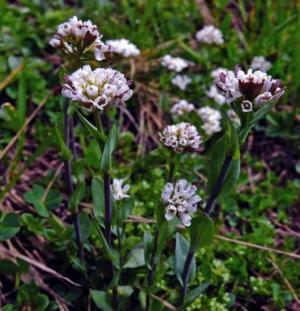Banat rockcress
(Noccaea banatica)

Description
Noccaea banatica, also known as Banat rockcress, is a species of plant in the Brassicaceae family. It is a small, herbaceous perennial plant that is native to the Balkans, specifically the Banat region, which spans parts of Romania, Serbia, and Hungary. This plant has been the subject of extensive study due to its unique adaptations to its harsh and rocky environment. In this article, we will explore the morphology, distribution, habitat, and ecological importance of Noccaea banatica. Morphology Noccaea banatica is a small plant that grows up to 25 centimeters tall. Its leaves are typically oblong or spatulate in shape, and they grow up to 7 centimeters long and 2 centimeters wide. The leaves are arranged in a rosette at the base of the plant. The stem of the plant is erect, and it produces a small inflorescence that contains yellow flowers with four petals. Distribution and Habitat Noccaea banatica is native to the Banat region of southeastern Europe. It can be found in rocky habitats, including limestone cliffs and rocky outcrops. The plant is adapted to grow in nutrient-poor soils, and it is often found in areas with high levels of heavy metals, such as zinc and cadmium. These heavy metals can be toxic to many other plant species, but Noccaea banatica has developed unique mechanisms to tolerate and even accumulate these metals. Cultivation Noccaea banatica is not commonly cultivated as a garden plant, as it is adapted to grow in harsh, rocky environments that are difficult to replicate in a garden setting. However, it is possible to grow Noccaea banatica from seed, and some specialized nurseries may carry it as a rare or unusual plant. If you are interested in growing Noccaea banatica, it is important to replicate its natural habitat as closely as possible. This means providing a well-draining soil mix that is low in nutrients, as the plant is adapted to grow in nutrient-poor soils. A mixture of sand, gravel, and a small amount of organic matter can provide a suitable growing medium. Noccaea banatica is a cold-hardy plant and can tolerate freezing temperatures, so it is best grown outdoors in a cool, temperate climate. It prefers full sun to partial shade, and should be watered sparingly to avoid overwatering, as it is adapted to survive in drought conditions. Propagation of Noccaea banatica can be done by seed, which can be collected from mature plants in the late summer or fall. The seeds should be sown immediately after harvesting, as they have a short viability period. They can be sown in pots or directly in the ground, and should be lightly covered with soil. Overall, while Noccaea banatica is not commonly cultivated, it is possible to grow it with some effort and attention to its unique growing requirements. However, it is important to remember that this species is adapted to harsh and fragile natural environments, and wild populations should be protected and conserved. Ecological Importance Noccaea banatica is an important plant species in its native ecosystem due to its ability to tolerate high levels of heavy metals. The plant has developed a unique mechanism for detoxifying heavy metals, which involves producing metal-binding proteins in its roots. These proteins bind to the heavy metals, preventing them from entering the rest of the plant and causing damage. As a result, Noccaea banatica is able to grow in environments that are toxic to other plant species, making it an important pioneer species in the recolonization of disturbed areas. In addition to its ecological importance, Noccaea banatica has also been the subject of scientific study due to its potential applications in phytoremediation. Phytoremediation is the use of plants to remove pollutants from soil or water. Noccaea banatica has been shown to accumulate high levels of heavy metals in its tissues, making it a potential candidate for use in the remediation of contaminated sites. Conservation Status The conservation status of Noccaea banatica is currently listed as "Least Concern" on the International Union for Conservation of Nature (IUCN) Red List. This means that the species is not considered to be at significant risk of extinction in the near future. However, some populations of Noccaea banatica may be threatened by habitat loss or degradation, particularly due to human activities such as mining or urbanization. As such, conservation efforts may be necessary to ensure the long-term survival of this species and its unique adaptations. Conclusion Noccaea banatica is a small but significant plant species that is native to the Banat region of southeastern Europe. Its unique adaptations to its rocky and metal-rich environment make it an important pioneer species in disturbed areas, and its potential applications in phytoremediation make it a subject of interest in scientific research. Understanding the biology and ecology of Noccaea banatica can help us better understand how plants have evolved to survive in harsh environments, and may also provide insights into new approaches for environmental remediation.
Taxonomic tree:







